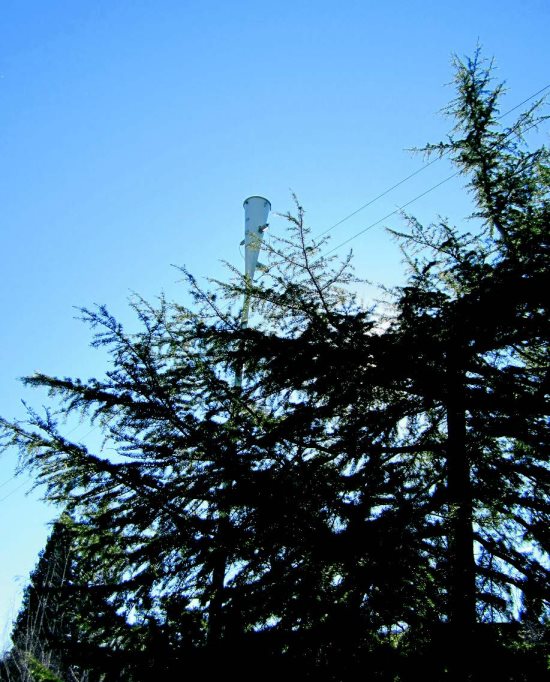 | | | Trees growing too close to power lines Photo Vera Kochan | | | | | | Before the next fire season gets underway Pacific Gas and Electric Co. has expanded its Community Wildfire Safety Program to include Moraga within the coming months, depending on weather and other factors. The program is a precautionary measure to reduce the risk of wildfires and keep the community safe.
 Moraga is designated as an "extreme fire threat area" due to all of the vegetation in and around the town. Jennifer Shepherd, a PG&E wildfire safety location specialist, said, "Letters will be sent out by mail to inform residents of the upcoming increased activity and presence of PG&E personnel. We want people to be aware that we will be there in a proactive capacity."
Moraga is designated as an "extreme fire threat area" due to all of the vegetation in and around the town. Jennifer Shepherd, a PG&E wildfire safety location specialist, said, "Letters will be sent out by mail to inform residents of the upcoming increased activity and presence of PG&E personnel. We want people to be aware that we will be there in a proactive capacity."
 The crews will be inspecting transmission towers and lines. This will include both visual and aerial inspections from top to bottom.
The crews will be inspecting transmission towers and lines. This will include both visual and aerial inspections from top to bottom.
 The visual inspections will require the ground examination of poles and climbing of towers. The work will be performed by up to four people and take approximately two hours per structure to complete.
The visual inspections will require the ground examination of poles and climbing of towers. The work will be performed by up to four people and take approximately two hours per structure to complete.
 Aerial inspections may include flying a drone around the tower for 30-45 minutes depending on the structure. For some tower locations, a helicopter may be required to inspect or to transport crews to remote areas.
Aerial inspections may include flying a drone around the tower for 30-45 minutes depending on the structure. For some tower locations, a helicopter may be required to inspect or to transport crews to remote areas.
 PG&E wants to "enhance our routine vegetation management work to meet and exceed state vegetation and fire safety standards, which require clearance of four feet around power lines in high fire-threat areas with recommended minimum clearances of 12 feet or more, at time of trim, to ensure compliance year-round."
PG&E wants to "enhance our routine vegetation management work to meet and exceed state vegetation and fire safety standards, which require clearance of four feet around power lines in high fire-threat areas with recommended minimum clearances of 12 feet or more, at time of trim, to ensure compliance year-round."
 The upcoming inspections will allow PG&E to address the issue of overhanging limbs and branches above and around the power lines. They will also conduct targeted removal of dead and dying trees.
The upcoming inspections will allow PG&E to address the issue of overhanging limbs and branches above and around the power lines. They will also conduct targeted removal of dead and dying trees.
 Many factors are involved in assessing trees that can cause fire risk to power lines. Oak trees, pine trees, Douglas fir and eucalyptus are just some of the vegetation that are problematic when they are in poor health or dying. Because these trees can grow tall and have outreaching limbs, striking a nearby power line while falling is a good possibility.
Many factors are involved in assessing trees that can cause fire risk to power lines. Oak trees, pine trees, Douglas fir and eucalyptus are just some of the vegetation that are problematic when they are in poor health or dying. Because these trees can grow tall and have outreaching limbs, striking a nearby power line while falling is a good possibility.
 Shepherd noted, "If, during the inspections, any of the dangerous trees are located on private property, PG&E will notify the resident through a company representative. If no one is home, a doorknob-hang notification will be placed on the front door with pertinent information and procedures."
Shepherd noted, "If, during the inspections, any of the dangerous trees are located on private property, PG&E will notify the resident through a company representative. If no one is home, a doorknob-hang notification will be placed on the front door with pertinent information and procedures."
 Anyone with questions for PG&E can call 1-800-PGE-5000 or email wildfiresafety@pge.com. To learn more about the Community Wildfire Safety Program visit www.pge.com/wildfiresafety.
Anyone with questions for PG&E can call 1-800-PGE-5000 or email wildfiresafety@pge.com. To learn more about the Community Wildfire Safety Program visit www.pge.com/wildfiresafety. |
